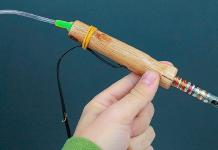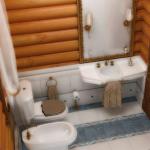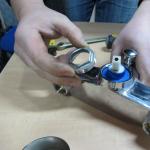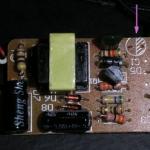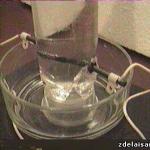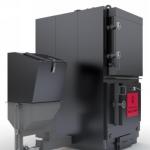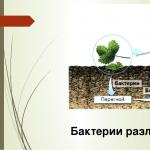There are many technologies for welding various materials, and among them is capacitor welding. The technology has been known since the 30s of the last century and is a variety. The connection of metals occurs during melting in places of a short circuit of the electric current due to the applied energy of the discharge of charged high-capacity capacitors. The process takes 1-3 milliseconds.
The basis of the apparatus is a capacitor or a block of capacitors, which are charged by a DC power supply. Capacitor electrodes, after reaching the required energy level during the charging process, are connected to the welding points. The current flowing during the discharge between the parts to be welded causes the surfaces to heat up to such an extent that the metal melts and quality is formed.
Despite a number of advantages, capacitor welding has a number of limitations that do not allow it to be used everywhere. Among them:
| pros | Minuses |
|---|---|
| high process speed in automated production, up to 600 points per minute | short-term power of the welding process |
| accuracy of connection of parts and repeatability of processes on the line | restrictions on the dimensions of the section of welded parts |
| does not transmit infrared and ultraviolet radiation | impulse load creates interference in the network and high short-term loads |
| equipment durability | |
| welding of different metals | |
| low heat generation, no need for coolant | |
| no consumables such as electrodes or welding wire |
Despite some shortcomings, the method of joining metals has been widely used in industry and in everyday life.
Types of welding capacitor machines
There are two types of capacitor welding machines - with the discharge of energy storage devices directly on the surfaces to be welded and with a discharge from the secondary winding of the transformer. The first, transformerless method, is more often used in shock-capacitor welding. The second method, transformer, is used to create a high-quality seam.
Shock-capacitor equipment welds the parts during the impact of one of the electrodes on the part. During impact, the surface parts are tightly pressed against each other. A capacitor discharge occurs, forming a microarc that heats the surfaces to the melting point of metals. The parts are firmly connected.
In the transformer welding method, the capacitor after charging is connected to the primary winding of the step-down transformer. A potential appears on the secondary winding, several times smaller than the amplitude of the incoming pulse. During the discharge, parts are welded, the capacitor is charged again and again gives energy to the primary winding of the transformer. This allows for long bursts of up to 5 discharges per second, which create strong and precise welds.
Application Specifics
Capacitor welding is an economical process, so it is convenient to use it at home with a single-phase low power network. The industry produces household welders with a power of 100-400 watts, which are designed for home use or in small private workshops.
Capacitor welding has gained particular popularity in car body repair shops. Unlike arc welding, capacitor welding does not burn through and does not deform the thin walls of sheets of body parts. There is no need for additional straightening.
Also, capacitor welding is used in radio electronics for welding products that are not soldered using conventional fluxes or fail from overheating.
Capacitor welders are used by jewelers to make or repair jewelry.
In industry, the point connection is used for:
- welding of bolts, hooks, nuts, studs and other hardware to surfaces;
- connections between different metals, including non-ferrous;
- welding of watch parts, photo and film equipment;
- manufacture of optical and lighting devices;
- assembly of electronic equipment
- and etc.
Capacitor welding is used to connect microscopic parts that cannot be welded with an arc method.
Do-it-yourself capacitor apparatus
A capacitor-type welding machine can be made independently and used for domestic purposes. For this you will need
- transformer for 220 volts with a power of 5-20 W with an output voltage of 5V;
- four rectifier diodes with a direct current of at least 300mA (for example, D226b);
- thyristor PTL-50, modern replacement for T142-80-16, KU 202 or similar;
- electrolytic capacitor 1000.0 x25 V;
- variable resistor 100 ohm;
- transformer with a power of at least 1000 W (suitable for microwave ovens);
- electrodes or a welding gun (different designs are described many times on the Internet pages);
- copper wire with a cross section of at least 35 mm2 - 1 meter.
- switches, fuses, housing at the discretion.
If the installation is carried out according to the scheme without errors and the parts are in good order, then there will be no problems with the performance of the device.
There is only one problem - the output transformer. If you really decide to use a microwave transformer, and you can buy it cheaply in the markets for used parts, then get ready that it needs to be redone.
It is necessary to remove the magnetic shunts and the secondary winding and wind 2-5 turns of the secondary winding with a thick copper wire on the vacated place. During the tuning process, the number of turns may need to be changed. It is considered optimal that the output voltage should fluctuate within 2-7 volts, but this value also depends on the duration of the welding pulse, the thickness of the materials being welded. No need to be afraid to experiment by choosing different modes with a variable resistor and changing the number of turns. But do not try to get out of the apparatus what a conventional arc process can do. It will not work to cook water pipes and fittings, this device is for other purposes.
Apparatus for the transformerless type is not much more complicated, but they are more cumbersome. You will need a set of capacitors with a total capacity of about 100,000 microfarads. This is a decent size and weight battery. It can be replaced with a compact ionistor, but the device is not cheap. In addition, electrolytic capacitors are not durable. Therefore, portable and household capacitor spot welding machines are usually manufactured according to a transformer circuit.
Modern devices are manufactured using slightly different technologies. The frequency and power of the discharge is regulated by PIC controllers, it is possible to automate processes, control via a computer or monitor interface. But the physical processes of welding have not changed. Having assembled the simplest unit once, you can later add elements of computer control, production automation and control to it.
If this topic is close to you and you are ready to supplement or challenge it, share your opinion, tell us, post descriptions of your decisions in the comment block.
There are several ways to seamlessly connect metal elements, but capacitor welding occupies a special place among all. The technology has become popular since about the 30s of the last century. Docking is carried out by supplying electric current to the desired location. A short circuit is created that allows the metal to melt.
Advantages and disadvantages of technology
The most interesting thing is that capacitor welding can be used not only in industrial conditions, but also in everyday life. It involves the use of a small-sized apparatus that has a constant voltage charge. Such a device can be easily moved around the working area.
Among the advantages of the technology, it should be noted:
- high work productivity;
- durability of the equipment used;
- the possibility of connecting various metals;
- low level of heat release;
- no additional consumables;
- the accuracy of the connection of elements.
However, there are situations when it is impossible to use capacitor welding to connect parts. This is primarily due to the short duration of the power of the process itself and the limitation on the cross section of the combined elements. In addition, the impulse load is capable of creating various interferences in the network.

Features and specifics of application
The process of joining workpieces involves contact welding, for which a certain amount of energy is consumed in special capacitors. Its release occurs almost instantly (within 1 - 3 ms), due to which the heat-affected zone decreases.
It is quite convenient to carry out capacitor welding with your own hands, since the process is economical. The device used can be connected to a conventional electrical network. For industrial use, there are special high power devices.
The technology gained particular popularity in workshops designed to repair vehicle bodies. During the work they do not burn through and are not subjected to deformation. The need for additional straightening is eliminated.
Basic process requirements
In order for capacitor welding to be performed at a high quality level, certain conditions must be observed.

- The pressure of the contact elements on the workpieces directly at the moment of impulse must be sufficient to ensure a reliable connection. Opening the electrodes should be done with a slight delay, thereby achieving the best mode of crystallization of metal parts.
- The surface of the workpieces to be joined must be free of contaminants so that oxide films and rust do not cause too much resistance when the electrical current is applied directly to the workpiece. In the presence of foreign particles, the efficiency of the technology is significantly reduced.
- Copper rods are required as electrodes. The diameter of the point in the contact zone must be at least 2-3 times greater than the thickness of the element to be welded.
Technological methods
There are three options for influencing workpieces:
- Capacitor spot welding is mainly used to connect parts with different thickness ratios. It is successfully used in the field of electronics and instrumentation.
- Roller welding is a certain number of spot joints made in the form of a continuous seam. The electrodes are like rotating coils.
- Impact capacitor welding allows you to create elements with a small cross section. Before the collision of the workpieces, an arc discharge is formed, which melts the ends. After the parts come into contact, welding is carried out.

As for the classification according to the equipment used, it is possible to divide the technology by the presence of a transformer. In its absence, the design of the main device is simplified, and the bulk of heat is released in the zone of direct contact. The main advantage of transformer welding is the ability to provide a large amount of energy.
Do-it-yourself capacitor spot welding: a diagram of a simple device
To connect thin sheets up to 0.5 mm or small parts, you can use a simple design made at home. In it, the impulse is fed through a transformer. One of the ends of the secondary winding is connected to the array of the main part, and the other - to the electrode.

In the manufacture of such a device, a scheme can be used in which the primary winding is connected to the electrical network. One of its ends is output through the diagonal of the converter in the form of a diode bridge. On the other hand, a signal is supplied directly from the thyristor, which is controlled by the start button.
The impulse in this case is generated using a capacitor having a capacitance of 1000 - 2000 microfarads. For the manufacture of a transformer, a Sh-40 core with a thickness of 70 mm can be taken. The primary winding of three hundred turns is easy to make from a wire with a cross section of 0.8 mm marked PEV. A thyristor with the designation KU200 or PTL-50 is suitable for control. The secondary winding with ten turns can be made of a copper bus.

More powerful capacitor welding: diagram and description of a homemade device
To increase the power indicators, it will be necessary to change the design of the manufactured device. With the right approach, it will be possible to connect wires with a cross section of up to 5 mm, as well as thin sheets with a thickness of not more than 1 mm. To control the signal, a non-contact starter marked MTT4K is used, designed for an electric current of 80 A.
Typically, the control unit includes thyristors connected in parallel, diodes and a resistor. The response interval is adjusted using a relay located in the main circuit of the input transformer.
Energy is heated in electrolytic capacitors combined into a single battery by means of the table. You can find the necessary parameters and the number of elements.
The main transformer winding is made of a wire with a cross section of 1.5 mm, and the secondary is made of a copper bus.

The work of a homemade apparatus occurs according to the following scheme. When the start button is pressed, the installed relay is activated, which, using thyristor contacts, turns on the transformer of the welding unit. Shutdown occurs immediately after the capacitors are discharged. The impulse action is adjusted by means of a variable resistor.
Contact block device
The manufactured fixture for capacitor welding should have a convenient welding module that provides the ability to fix and move the electrodes without hindrance. The simplest design involves manual holding of the contact elements. In a more complex version, the lower electrode is fixed in a stationary position.
To do this, on a suitable base, it is fixed with a length of 10 to 20 mm and a cross section of more than 8 mm. The top of the contact is rounded off. The second electrode is attached to a platform that can move. In any case, adjusting screws must be installed, with which additional pressure will be applied to create additional pressure.
It is imperative to isolate the base from the movable platform until the contact of the electrodes.

Work procedure
Before do-it-yourself spot capacitor welding is done, you need to familiarize yourself with the main steps.
- At the initial stage, the elements to be connected are prepared properly. Contaminants in the form of dust particles, rust and other substances are removed from their surface. The presence of foreign inclusions will not allow to achieve high-quality docking of workpieces.
- Parts are connected to each other in the required position. They should be located between two electrodes. After squeezing, an impulse is applied to the contact elements by pressing the start button.
- When the electrical action on the workpiece stops, the electrodes can be moved apart. The finished part is removed. If there is a need, then it is installed at a different point. The thickness of the element to be welded directly affects the size of the gap.
The use of ready-made devices
Work can be carried out using special equipment. This kit usually includes:
- apparatus for creating an impulse;
- fixture for welding and clamping fasteners;
- return cable equipped with two clamps;
- collet set;
- instructions for use;
- wires for connecting to the mains.
Final part
The described technology for connecting metal elements allows not only welding steel products. With its help, you can join parts made of non-ferrous metals without much difficulty. However, when performing welding work, it is necessary to take into account all the features of the materials used.
The technology has been known since the 30s of the last century, however, it has not lost its relevance to this day. This method is designed to fasten small parts together, and the most popular materials for such procedures are aluminum and copper. Due to its simplicity and the ability to use the device in private production, this variety has gained popularity among novice welders, and it is easy to do it yourself.
Distinctive features
Standard welding involves the operation of complex equipment that uses special electrodes. They are applied to the treated surface, which creates ignition of the winding, leading to the melting of rolled metal. Further, the molten metal flows into the bath, where, after solidification, it fastens the elements. Only an experienced person can handle such a thing, and the emitted gas and ultraviolet will have a negative effect on the body. It should be noted that it is impossible to weld small components with this system.
Capacitor welding does not harm the environment, and after manipulations on the plane, there are practically no traces of external influences. Also, this approach will help save electricity, and the process requires a minimum of personal protective equipment. The device does not require cooling, and everything will take a minimum of time. A special moment can be called the high accuracy and accuracy of the connection. The equipment is compact, and its scope is microwelding and electric welding of large sections.
Operating principle
Objects are tightly held together by two conductors, which are supplied with a short-term discharge of electricity. This reaction creates an arc that melts the steel with its heat. After the impulse, compression under load continues, making a common seam for a pair of items. If we consider the event in more detail, then it goes like this:
- storage capacitors collect the necessary energy, which comes through the primary circuit;
- when the electrode contacts the material being processed, an intense burst of particles enters, which contributes to heating and melting of rolled metal;
- then everything happens again and in the same sequence.
Activities can be carried out with a limited number of rentals, and with a thickness of no more than 0.15 cm.
Important! In this manner, it is possible to weld a thin wire to a solid steel surface, while the chemical composition of the alloys can vary significantly.
It should be noted that the result of the connection is obtained with very positive properties, and the unit does not have to buy consumable components. During use, the manifestation of a load that creates interference in the mains is allowed. Despite this, the capacitor clamping approach is widely used in both large industry and private use.
Varieties
The riveting of both sections occurs due to the strong electrical influence that accumulates in the two-terminal networks, and the process itself is divided into three categories:
- contact implies a tight pressing of both workpieces, and contact of the electrodes to the required place. As a result of touching, electric energy is supplied to a small space of the object, the temperature of which contributes to melting and future attachment. Regarding the voltage, it is equal to 15 kA, and acts for 0.3 seconds;
- impact technology is also designed to connect both elements, however, the supply of electricity is carried out using a short impact. The operation time is reduced to 1.5 m/s, which reduces the melting area;
- dot technique. In this situation, you will need two copper contacts that touch the object from two faces. The intensity of the current reaches 10 kA, and the bonding of products occurs at the point of contact.
So you can repair cables, restore household electrical appliances, remake small automotive components, and more. And the main advantage is that it does not require the purchase of expensive equipment. An analogue of such an installation can be made by anyone at home.
Requirements for capacitor welding
For the manufacture of a high-quality design, it is recommended to consider some rules:
- a good supply of short-term flow is created, with an activity period of no more than one millisecond;
- the rapid accumulation of new energy for the next action is ensured (in the shortest possible time);
- the conductors are strong enough to hold the sheets, while they must quickly disconnect to reduce the temperature;
- the rods are selected from copper, and their thickness must be three times greater than the thinnest point of the sheet;
- before processing, the object is thoroughly cleaned of rust, dirt and grease.
Do-it-yourself capacitor welding will be good only if there are 2 power units. Among other things, it is necessary to provide for the adjustment of the flow rate for different types of work, and take care of high-quality safety equipment.
A simple scheme for spot welding
Here it is relevant to consider a simplified model that transmits an impulse through an electromagnetic device. In the course of work, it is necessary to connect the first wire directly to the workpiece, and the secondary one to the transmitter. Pressing the components is possible using the "crocodile". The scheme of the device is as follows: the primary transformer coil is connected to the network (one of its ends is passed through a diode bridge). The other side of the same bridge receives a signal from the thyristor.
After starting, the charge will accumulate in the transistors (they are located in the semiconductor device chain and connected to the transformer bridge). Electric current will be taken from this link in the future.
The sequence occurs in the following manner: first, the two-terminal devices are charged from the mains. After starting, charging is turned off, and the current passes to the electromagnetic device bypassing the resistor. The duration can be controlled using a special regulator.
It is the transformer that belongs to the key links of the module. It can be formed in the likeness of a core with dimensions of 40 by 70 (length and width). The primary layer is made from 0.08 cm cable and is wrapped 300 times. The secondary is made with a wire tire with a size of 2 cm, and 10 turns are made to it. You can take any transformer, however, its power must be 10 W, and the voltage is 15 V.
High power device
Here it is necessary to redo the unit according to a different method, but this will make it possible to weld thicker sheets and wire. This is also a homemade design, but capacitor welding will turn out just as well. To create it, you will need: an MTT4K starter with a current of 8 A and a return voltage of 800 V. Thyristors, a pair of diodes and one resistor are attached to the control module.
All reactions proceed as in the previous case, but here attention must be paid to the choice of capacitors. Their presence is 3 pairs with the following power:
- 1st 47uF;
- 2nd 100uF;
- 3rd 470uF.
In this case, the voltage must be at least 50 V. You will also need a reed relay with a voltage of 20 V. As for the winding, then you need a 1.5 mm wire and a bus with 60 mm 2. The strength of the electric current in the cooking zone will reach 1500 A.
Of course, such equipment cannot weld pipes or fittings, but for small cases it will be a great helper.
contact block
The device is responsible for fastening and moving the rods. In most situations, the setup involves fixing a hand sample. A better one fixes the lower one, and makes the upper rod movable (the finished block resembles a vise). A copper rod of small length and with a circumference of 0.8 cm is fixed here. It must move freely in a vertical plane. The bottom one remains stationary. A screw sample regulator is also installed on the upper part, thanks to which additional pressure can be created. At the same time, the upper platform and the base of the power unit must be endowed with good insulation from each other. In some models, a flashlight can be attached on top, this will give additional convenience for work.
Product preparation. High-quality riveting will succeed with perfectly clean surfaces. They should be free of dirt, corrosion, foreign mixtures and other things. Connection of parts. Here the alloys are placed in the required way, installed between two contacts and squeezed by them. After pressing the start button, the welding procedure begins, and at the end the electrodes are disconnected. Repeat. The second step is repeated until the entire area is securely welded. Also, the welder will need auxiliary construction tools: a chisel, a hammer, compasses, a knife, emery and more. They carry out the preparation, alignment and marking of the metal. Despite the simplicity of the whole process, the employee is obliged to strictly observe safety precautions. Failure to do so may result in electric shock or fire.
Greetings to all readers of the site " Volt-Index”, sometimes making certain projects on the basis of lithium batteries, many readers often criticize that lithium batteries cannot be soldered. This is of course true, but if you solder very quickly and do not heat up excessively, you can. In this article, we will try to make a capacitor type resistance welding machine.
In fact, there are a lot of options for building such devices on the Internet, but we will focus on the simplest and most trouble-free. This is transformerless or impact resistance welding, so as not to get confused later, I want to say that the transformer is in our diagram.
Yet there is, it is designed to charge the capacitor. But there are welding machines where the capacitance of the capacitor is discharged at the welding site not directly, but through an isolation transformer.
Such devices are called transformers.
Unlike conventional resistance welding machines, in which the process occurs by heating two metals, capacitor welding does not heat the part due to the very short welding process. This is especially good for soldering batteries.
In the circuit, S3 is connected to ground. In the archive on the diagram, everything is fixed.
The principle of operation is the following.
The voltage from the mains transformer is rectified by a full-wave rectifier and charges a large-capacity electrolytic capacitor. It is advisable to use a battery of parallel-connected capacitors of the same voltage and capacity.
To be honest, the capacitances may differ, but it is important that the capacitors have the same rated voltage.
At the time of welding, the entire capacitance of the capacitor is discharged at a certain point, to which removable contacts are connected. Moreover, as these contacts, the parts themselves can sometimes be used, which must be welded together.
The momentary discharge of the capacitance of powerful capacitors causes a huge current surge, the process is very short-lived, but the currents can reach tens of thousands of amperes, depending on the capacitance and voltage of the capacitor bank. A short-term discharge of such a capacity leads to instantaneous melting of the metal under the electrodes.
The voltage was chosen around 40 volts. Such tension is completely safe for humans, although it all depends on the physiology of the individual. For someone and 12 volts maximum.
But, in any case, 40 volts is not fatal. Since the device was planned to be powered from the mains, a step-down transformer must be used to charge the capacitors.
In our case, a transformer was used that outputs about 30 volts on the secondary at a current of 1.5 amperes, which is great for our purposes.
After the rectifiers, the voltage across the capacitors will be about 40 volts. Naturally, due to an unstabilized source, this voltage may deviate in one direction or another, depending on the voltage in the network.
In principle, any transformer with a power of more than 50 watts, which provides the desired voltage at the output, will do. The charging time of the capacitors will depend on the current of the secondary winding.
To limit the charge current of the capacitor, a 10-watt wire-type resistor with a resistance of 10-15 ohms was used.
If you do not limit the charge current, then the system will consume enormous currents, as a result of which the diode bridge may burn out.
The device is provided with a thyristor contactor.
When a low-current button is pressed, a powerful thyristor will work, which will discharge the entire capacity of the capacitor bank, that is, a short circuit will occur. In our case, a thyristor T 171-320 was taken.
The short-term surge current in our system can reach up to 4,000 amperes.
In order for this "monster" to work, you need to apply a voltage of 3.5 - 12 volts to the control electrode. The specified voltage can be obtained by using a voltage divider based on two 0.5 -1 watt resistors. By selecting them at the midpoint, you need to get the early indicated voltage.
A ready-made 10 Amp bridge was used as a diode rectifier, the voltage of the bridge was at least 100 volts, although such bridges are made for 400 or more volts. The bridge does not heat up during operation, but it is advisable to put it on a heat sink.
A chain of a resistor, an LED and a zener diode is an indicator of the charge of the capacitors, and when they reach about 40 volts, the LED lights up, which indicates that the device is ready for use.
You can also use a digital voltmeter.
In the absence of 40 volt zener diodes, several pieces of smaller ratings can be used.
You can take any LED, and the limiting resistor is 0.25 watts.
Capacitors were taken with a voltage of 50 volts - preferably 63 or 100 volts. The total battery capacity was 41,000 microfarads.
Of course, you can increase the capacitance of the capacitors, if only the thyristor can handle it, and an increase in capacitance will make it possible to weld larger parts.
The capacitors were soldered to a common board, the tracks were additionally reinforced. Also, a 5 watt 1.5 kΩ resistor was soldered in parallel to the capacitors. To discharge the latter after turning off the device. A button was also provided for an emergency discharge of the tank. Here the principle is the same - the discharge through the resistor only in this case it is low-resistance.
To start the thyristor, you can use absolutely any low-voltage button.
A simple dimmer can be incorporated into the primary circuit of the transformer. This will allow you to adjust the voltage on the capacitors and select the optimal voltage for welding parts from certain metals.

Capacitor welding is one of the types of contact welding, which is actively used in industry, as well as for do-it-yourself welding operations in everyday life.
The technological scheme of the operation is as follows: in capacitors, when they are charged from a rectifier, energy is accumulated, which, when discharged, is transformed into thermal energy.
With the help of this energy, the edges of metal products are connected. We will tell you how to do capacitor welding with your own hands: a diagram and a description of the technology.
Do-it-yourself condenser was developed back in the 30s of the XX century. Today, this technology is actively used by industrial enterprises and craftsmen to perform household welding operations.
This technology is especially popular in vehicle body repair shops: unlike the arc method, the capacitor method of creating a weld does not burn through and deform thin walls of body parts sheets. Subsequently, the connected body parts do not need additional straightening.
This technology is used in radio electronics to connect products that are not soldered using conventional fluxes or fail when overheated.
Capacitive welding devices are actively used by jewelers in the manufacture and repair of jewelry, in enterprises that produce communication cabinets, laboratory, medical, food equipment, in the construction of buildings, bridges, utilities.
Such a wide distribution can be explained by the action of a number of factors:
- simple design of the welding machine, which, if desired, can be assembled by hand;
- spot welding is characterized by relatively low energy consumption and low loads created on the electrical network;
- high performance indicators, which is extremely important in mass production;
- the ability to reduce the thermal effect on the surfaces to be joined, which makes it possible to weld small parts and work with those structures whose walls are excessively thin and can be deformed during conventional welding.
On a note! The advantage of capacitor welding technology is the simplicity of its implementation: even an average skill level allows the master to create high-quality welds.

The method of capacitor welding of the product.
The rules for the implementation of welding operations using the energy of capacitors are regulated by GOST. The principle of technology is based on the transformation of the energy of the electric charge accumulated on the capacitors into thermal energy.
When the electrodes come into contact, a discharge occurs and an electric arc of short duration is formed. Due to the heat generated by it, the edges of the metal parts to be joined are melted, forming a weld.
In capacitor welding, the current is applied to the welded electrode in the form of a short-term high-power pulse, which is obtained by installing high-capacity capacitors in the equipment.
In the case of resistance welding, the current is continuous. This is the main difference between these types of welding operations.
As a result, the master can achieve high rates of two important parameters:
- it takes much less time to heat the connected parts, which is especially valuable for manufacturers of electronic components;
- the current used to connect the parts has a high power, so the welds themselves are of better quality.
In the process of welding operations, for fastening elements and assemblies of different products, studs of different types and purposes may be required.
The advantage of capacitor welding is the ability to reduce the area of thermal impact, reduce stress and reduce the risk of surface deformation to zero due to the high energy density and short duration of the weld pulse. The technology allows you to work with non-ferrous metals with a small thickness.
We also note that a huge plus of the capacitor welded apparatus is its compactness. To apply this technology in practice, a powerful power source is not required, the device can be charged between moving the electrode to the next point.
Do-it-yourself capacitor welding
Contact welding is used by welders, so it is not difficult to buy a factory machine for its implementation.
Models as opposed to spot welding units , they are distinguished by a simple design, simple operation and are inexpensive, but many craftsmen still decide to assemble a capacitor-type welded apparatus with their own hands. This allows you to save money, realize your own talent.

Welding temperature of various materials.
Completing this task requires the master to:
- find on the Internet the necessary scheme and a detailed description of the structural features of the unit;
- understand the mechanism of operation of the device;
- choose relevant materials and fixtures: welded studs, welded electrodes, etc.
The mechanism of operation of the apparatus for capacitor welding:
- the current is directed through the primary winding of the supply transformer, a rectifier represented by a diode bridge;
- on the diagonal of the bridge, the control signal of the thyristor with the start button is supplied;
- a capacitor is inserted in the thyristor circuit to accumulate the weld pulse, which must also be connected to the rectifier diagonal and the primary winding of the transformer coil.
The connection of sections of metal structures is carried out with a strong electrical influence accumulated in two-terminal networks, and the process itself is divided into three categories:
- Contact welding.
It involves a tight pressing of the workpieces to each other, followed by contact of the electrodes to this place. The energy supplied to a limited space is so great that it leads to rapid melting and further attachment of the edges of the parts. - Impact technology.
It also involves the connection of individual metal parts into a single structure, but electricity is supplied to the place of welding in the form of a short-term shock. This technology makes it possible to reduce the duration of the welding operation to 1.5 m/s; - Dot technique.
When using this type of welding, two copper contacts are required that touch the object from two faces. As a result, the products are fastened at the point of contact with the electrode.
If necessary, hang devices fixed with nuts on a thin-sheet metal structure, you can use the same capacitor welding.
With its help, a special stud for capacitor welding is welded onto the wall of the structure, and the device is already fixed on it. The stud is placed against the base metal and the equipment is set up to perform the welding operation.
The arc melts the base of the stud and the area of the base metal corresponding to it, after which the product is introduced into the weld pool and fixed on the surface until the metals cool. This will take milliseconds to complete, but it will be reliable and durable.
Scheme for capacitor welding

Scheme of capacitor welding.
Do-it-yourself capacitor spot welding is easily performed even by an inexperienced welder.
Its basis is an electrical circuit using capacitors:
- The primary winding is carried out through the rectifier presented.
Then it is connected to a voltage source. - The thyristor sends a signal to the bridge diagonal and is controlled by the start button.
The capacitor is connected to the thyristor network, diode bridge and output to the primary winding. - You can charge the capacitor by turning on the auxiliary circuit with a rectifier and a transformer.
Do-it-yourself capacitor welding of batteries is carried out in the following sequence of actions on the part of the master:
- pressing the start button that starts the time relay;
- turning on the transformer using thyristors, after the relay is turned off;
- using a resistor to determine the pulse duration.
Requirements for capacitor welding
Welded capacitors are used on an industrial scale and in small workshops. In any case, do not violate the welding technology for batteries with your own hands, otherwise the welds will turn out to be of poor quality.

Electrical circuit of capacitor welding.
Compliance with the following conditions will allow you to get a really high-quality result of work:
- ensure the supply of a short-term pulse for a time interval of up to 0.1 s, as well as the subsequent accumulation of energy charge from the power source for a new pulse in the shortest possible time;
- take care of good contact of the parts to be welded by sufficient electrode pressure on the parts at the moment the welding pulse is applied;
- release the electrodes with a delay so that the melt cools under pressure and the mode of crystallization of the weld metal improves;
- the diameter of the point formed on the metal from contact with the electrode should be 2 times larger than the thinnest workpiece to be welded;
- thoroughly clean the surface of the workpieces to be welded before welding, so that oxide films and rust do not provoke significant resistance to current.
On a note! The most successful version of electrodes for capacitor welding is copper-plated wire.
Do-it-yourself capacitor spot welding can only be done if the unit is assembled with at least two blocks: a source of a weld pulse and a welding block. It is also extremely important to provide for the possibility of adjusting the welding mode and protection.
It is especially important to adhere to the safety rules with a welded machine, which include the following points:
- to protect the eyes from sparks from the welded machine, put on a special mask;
- gloves will help protect the skin of the hands from burns, and the body - a special protective overalls;
- the welder's feet are put on boots with a sole made of dense material that does not allow damage to the fingers and foot during work.
Contact block designs
The contact block of capacitor welding is responsible for fixing and moving welded. In most cases, the fixation of both rods is carried out manually.

Scheme of shock-type capacitor welding.
A better version provides a secure fixation of the lower rod, but leaves the upper rod movable. In this case, the upper copper rod is fixed so that it moves freely in a vertical plane. And the bottom one is left in a stationary state.
Also, a screw sample regulator is mounted on the upper part, which allows you to create additional pressure. The main thing is that the upper platform and the base of the power unit have good insulation from each other. Some models are equipped with a lantern on top, which makes the work more comfortable.
When designing capacitor welding with your own hands, you will need to have the following details:
- capacitor, with a capacity of 1000-2000 microfarads, a power of 10 V, a voltage of 15;
- a transformer of the required size - 7 cm, made from a Sh40 type core;
- primary winding made of three hundred layers of wire with a diameter of 8 mm;
- secondary winding of ten windings of a copper bus;
- starter of the MTT4K series, including parallel thyristors, diodes and a resistor.
On a note! If the work requires joining workpieces up to 0.5 cm, you will need to apply additional adjustments to the design scheme.
Features of the homemade unit
It is possible to carry out shock capacitor welding using a special factory-made apparatus, which is sold in specialized stores. However, it is quite realistic to make capacitor-type welding on your own in a small workshop.
Self-made units demonstrate high performance parameters and are not inferior to factory models in operation.

Homemade capacitor welding machine.
Before work, a home-made welding machine that uses the energy of capacitors is set with the main operating parameters:
- stress in the zone of metal products;
- type and strength of current;
- the duration of the weld pulse;
- the number and dimensions of the welded wire used in the work.
The control boards present in the design of both factory and home-made welding units provide the master with the opportunity to bring the incoming voltage and constant current to a stable value. It is important to equip a home-made unit with a switch for welding with electrodes without much difficulty.
Home-made units, like factory models, are durable, easy to use, if they are designed according to the scheme, technological requirements and safety standards.
And the technical parameters of the model made on its own must correspond to the characteristics of the factory designs. Then the device will allow even an inexperienced welder to perform reliable and durable welds using the capacitor welding method.
But do not forget that a significant share of success in performing welding operations depends on the thoroughness of the preparatory work. Be sure to make sure that the surfaces to be welded are free of dirt, dust, rust before starting work.
Such defects can negate the efforts of the welder, becoming an obstacle to the quality connection of the melted edges of the products.
Summing up
Capacitor welding is relevant when it is necessary to connect non-ferrous metal parts into a single structure.
The technology has a number of advantages, among which the ability to reduce the area of thermal exposure, reduce stress and eliminate the risk of deformation of metal surfaces is especially valuable. Capacitor welding machines are easy to use and easy to assemble with your own hands, which saves money.
